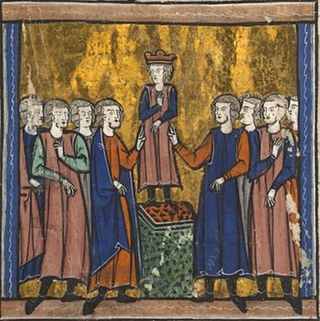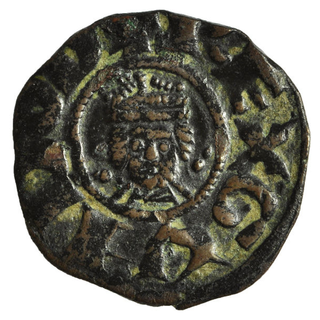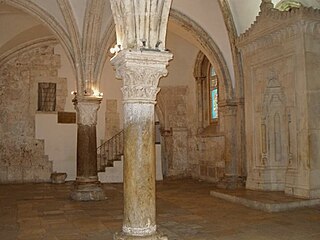
The Church of the Holy Sepulchre, also known as the Church of the Resurrection, is a fourth-century church in the Christian Quarter of the Old City of Jerusalem. The church is also the seat of the Greek Orthodox Patriarchate of Jerusalem. Some consider it the holiest site in Christianity and it has been an important pilgrimage site for Christians since the fourth century.
Year 1186 (MCLXXXVI) was a common year starting on Wednesday of the Julian calendar.

William of Tyre was a medieval prelate and chronicler. As archbishop of Tyre, he is sometimes known as William II to distinguish him from his predecessor, William I, the Englishman, a former prior of the Church of the Holy Sepulchre, who was Archbishop of Tyre from 1127 to 1135. He grew up in Jerusalem at the height of the Kingdom of Jerusalem, which had been established in 1099 after the First Crusade, and he spent twenty years studying the liberal arts and canon law in the universities of Europe.

Baldwin III was King of Jerusalem from 1143 to 1163. He was the eldest son of Melisende and Fulk of Jerusalem. He became king while still a child, and was at first overshadowed by his mother Melisende, whom he eventually defeated in a civil war. During his reign Jerusalem became more closely allied with the Byzantine Empire, and the Second Crusade tried and failed to conquer Damascus. Baldwin captured the important Egyptian fortress of Ascalon, but also had to deal with the increasing power of Nur ad-Din in Syria. He died childless and was succeeded by his brother Amalric.

Baldwin V was the king of Jerusalem who reigned together with his uncle Baldwin IV from 1183 to 1185 and, after his uncle's death, as the sole king from 1185 to his death in 1186. Baldwin IV's leprosy meant that he could not have children, and so he spent his reign grooming various relatives to succeed him. Finally his nephew was chosen, and Baldwin IV had him crowned as co-king in order to sideline the child's unpopular stepfather, Guy of Lusignan. When Baldwin IV died, Count Raymond III of Tripoli assumed government on behalf of the child king. Baldwin V died of unknown causes and was succeeded by his mother, Sibylla, who then made Guy king.

Guy of Lusignan was a French Poitevin knight who reigned as the king of Jerusalem from 1186 to 1192 by right of marriage to Sibylla, and King of Cyprus from 1192 to 1194.

Godfrey of Bouillon was a preeminent leader of the First Crusade, and the first ruler of the Kingdom of Jerusalem from 1099 to 1100. Although initially reluctant to take the title of king, he agreed to rule as prince (princeps) under the title Advocatus Sancti Sepulchri, or Advocate of the Holy Sepulchre.

Fulk, also known as Fulk the Younger, was King of Jerusalem with his wife, Queen Melisende, from 1131 until his death in 1143. Previously, he was Count of Anjou from 1109 to 1129. During Fulk's reign, the Kingdom of Jerusalem reached its largest territorial extent.

Sibylla was the queen of Jerusalem from 1186 to 1190. She reigned alongside her husband Guy of Lusignan, to whom she was unwaveringly attached despite his unpopularity among the barons of the Kingdom of Jerusalem.
Heraclius or Eraclius, was archbishop of Caesarea and Latin Patriarch of Jerusalem.

The king or queen of Jerusalem was the supreme ruler of the Kingdom of Jerusalem, a Crusader state founded in Jerusalem by the Latin Catholic leaders of the First Crusade, when the city was conquered in 1099. Most of them were men, but there were also five queens regnant of Jerusalem, either reigning alone suo jure, or as co-rulers of husbands who reigned as kings of Jerusalem jure uxoris.

The Cenacle, also known as the Upper Room, is a room in Mount Zion in Jerusalem, just outside the Old City walls, traditionally held to be the site of the Last Supper, the final meal that, in the Gospel accounts, Jesus held with the apostles.

Maria Komnene, Latinized Comnena, was the queen of Jerusalem from 1167 until 1174 as the second wife of King Amalric. She occupied a central position in the Kingdom of Jerusalem for twenty years, earning a reputation for intrigue and ruthlessness.
Joscius was Archbishop of Tyre in the crusader Kingdom of Jerusalem in the late 12th century.

Jerusalem's role in first-century Christianity, during the ministry of Jesus and the Apostolic Age, as recorded in the New Testament, gives it great importance, both culturally and religiously, in Christianity. Jerusalem is generally considered the cradle of Christianity.

The Siege of Jerusalem of 1244 took place after the Sixth Crusade, when a Khwarazmian army conquered the city on July 15, 1244.
The title of Advocatus Sancti Sepulchri, or Advocate of the Holy Sepulchre, has been ascribed to Godfrey of Bouillon in his role as the first Latin ruler of Jerusalem. In the aftermath of the First Crusade, there was disagreement among the clergy and secular leaders as the leadership of the Kingdom of Jerusalem. There was opposition to the naming of a king over the Holy City and the wearing of a crown in the city where Christ suffered with a crown of thorns. The original sources differ on the actual title assumed by Godfrey. However, it is generally accepted by most modern historians that, once Godfrey was selected to be leader, he declined to be crowned king instead taking the titles of prince (princeps) and advocate or defender of the Holy Sepulchre.

Elzear Horn was a German Catholic friar and missionary of the Franciscan Order who is best known for his travelogues of Palestine.
Zehava Jacoby was an Israeli art historian who specialized in Crusader art.














